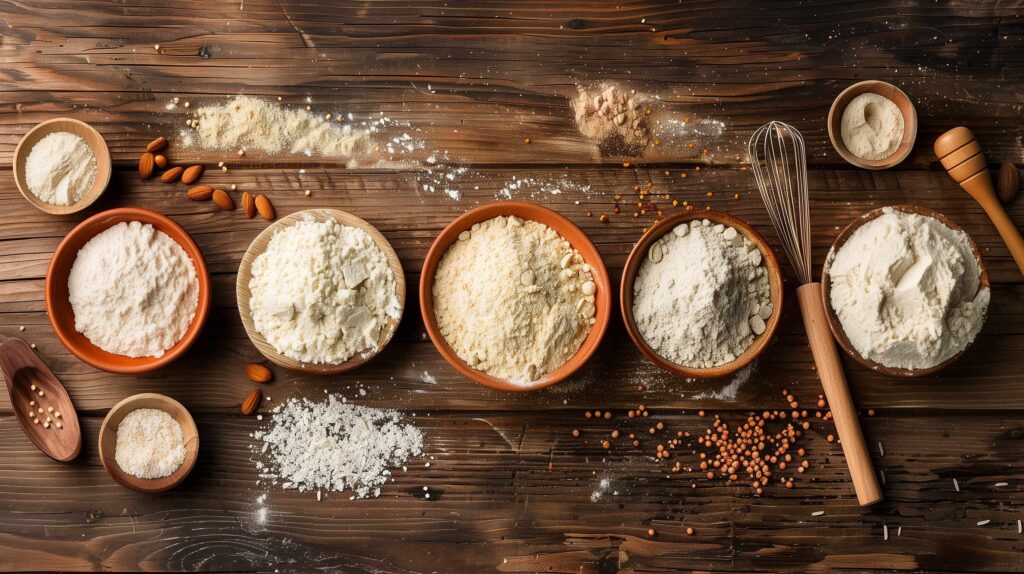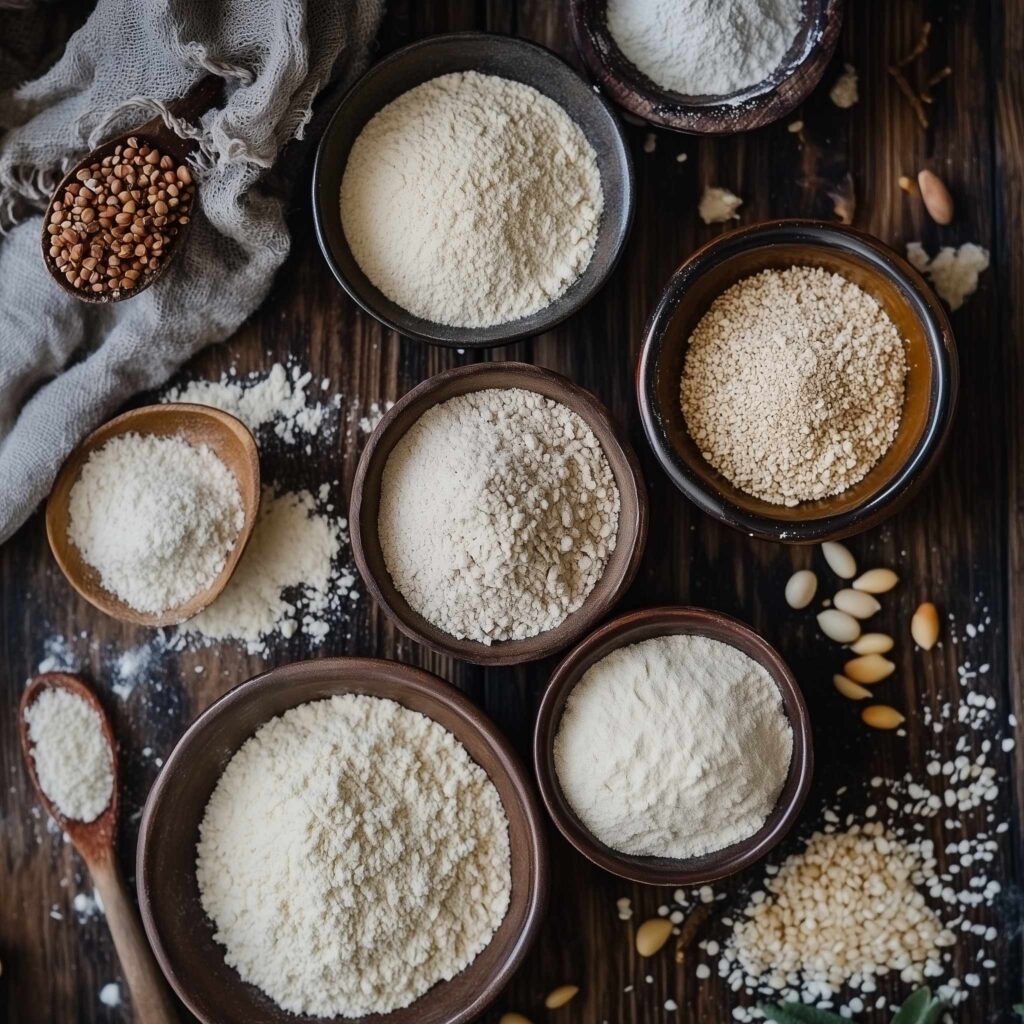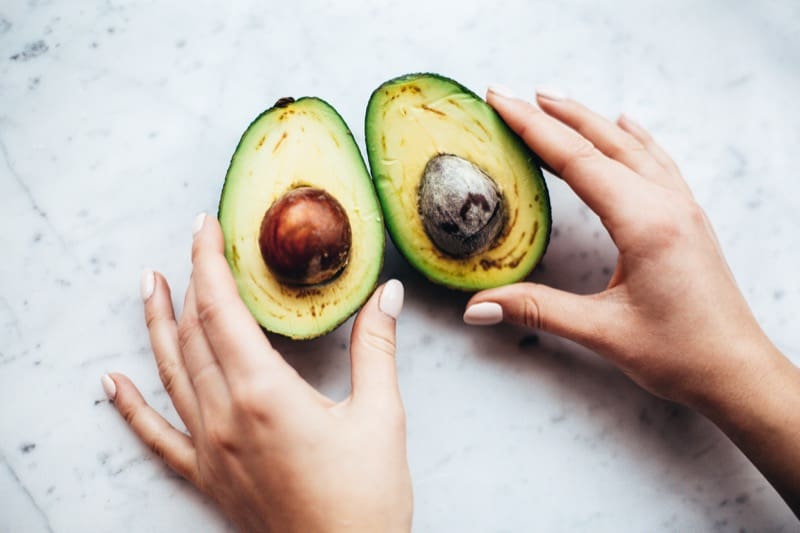
Baking Gluten-Free: Essential Flour Substitutes and Their Best Uses
The demand for gluten-free products has boomed recently, with the gluten-free food manufacturing industry raking in about $200 million in 2021. The popularity is in part because of increasing awareness of gluten sensitivity and coeliac disease, as well as the association of gluten-free diets with weight loss and better health. Since gluten is found in common baking flours like wheat, oats, rye, and barley, the challenge of gluten-free baking is finding gluten-free flour substitutes without compromising on flavour and texture. This article will look at some common gluten-free flour substitutes and how to bake gluten-free.

Understanding Gluten and Its Role in Baking
Gluten is a network of protein molecules that forms when water is mixed with glutenous flours. It provides dough a certain elasticity that gives bread its air-pocketed structure and characteristic chewy texture. Gluten is present not only in bread and other baked goods (such as muffins, cakes, biscuits, etc.) but many other foods. These include pastas, cereals, beers, and things thickened with glutenous flours, such as soups, salad dressings, and roux.
Why Go Gluten-Free?
For coeliac disease sufferers, going gluten-free is a necessity. Gluten causes inflammation and flattening of the lining in the small intestine, impacting the absorption of nutrients. If not managed properly, this could lead to long-term malnutrition, chronic inflammation, and a number of other medical issues.
Some people also have gluten ataxia, wheat allergies, or a non-coeliac gluten sensitivity, which often has similar symptoms to coeliac disease. Because some gluten-free flour substitutes are high in fibre and nutrients, they can have more nutritional benefits than ‘regular’ flour — which is attractive for people looking to eat more healthily.
Common Gluten-Free Flour Substitutes
Here are some of the best gluten-free flours to incorporate into your gluten-free baking.
Almond Flour
Almond flour is made from finely ground, blanched almonds. It brings a rich, nutty flavour and is high in protein, minerals, vitamin E, and monounsaturated fat.
It can usually be substituted for wheat flour 1:1. It is great for cakes, breads, and cookies, but you may need to add an extra egg or binding ingredient to thicken your batter. Instead of breadcrumbs, you could try an almond flour gluten-free coating for fried or baked foods for a satisfying crunch.
Coconut Flour
Coconut flour is finely ground, dried coconut meat, so it adds a mild coconut flavour to foods. Its high fibre content is good for blood sugar levels because it does not cause a strong spike.
Coconut flour baking results are similar to wheat flour. It is great for pancakes, muffins, dense cakes, and desserts, but it absorbs more liquid than regular or almond flour. You can substitute a 1/4 cup of coconut flour for regular flour, or add more liquid to your batter.
Rice Flour
Rice flour comes in white and brown varieties. White rice flour is easy to digest and adds a fluffiness to cakes and other baked goods. It also makes a good dredge and thickener. Brown rice flour is whole-grain, with high protein and fibre. It has a nutty flavour and can be used as a thickener and for breading.

Rice flours are light but can be gritty if not finely milled. They are also often blended with other flours for baking. You can find many rice flour gluten-free recipes online.
Sorghum Flour
Sorghum is a cereal grain that has been grown for centuries. It is low in fat and high in iron, fibre and other nutrients. It has a mild, sweet flavour and works well in breads, muffins, and pancakes. There are many sorghum flour uses — even the unmilled grains themselves can be popped like popcorn.
It is rather dense flour, so often blended with other, lighter gluten-free flours. It should be about 25% of the total flour mix.
Tapioca Flour (Tapioca Starch)
Tapioca flour and starch both come from the cassava root but are slightly different products. The flour is made from finely ground cassava root — including the outer layer and starchy core — whereas tapioca starch is extracted through a process that separates out the starchy parts. Tapioca starch has a higher concentration of starch and carbohydrates. Tapioca flour and starch are perfect as thickeners. To baked goods, they also add a lightness and a satisfying chew. Tapioca flour baking is also a great way to branch into Asian desserts.
Since it has little nutritional value aside from its resistant starch content, it should be mixed with whole-grain gluten-free flours to make more healthy treats.
Chickpea Flour (Besan Flour)
Chickpea flour, also called garbanzo, gram, or besan flour, is made from ground, dried chickpeas. Chickpeas are not grains but legumes.
Chickpea flour benefits are mostly nutritional since chickpeas are an excellent source of protein, minerals, and fibre. This flour has a slightly nutty, earthy taste, making it perfect for savoury dishes such as socca, fritters, and dense cakes.
Chickpea flour can be hard to digest for some people, so it should be blended with other gluten-free flours and make up about 25% of the total flour mixture.
Buckwheat Flour
Despite its name, buckwheat contains no wheat. It is, however, high in protein, fibre, and B vitamins and provides a rich, earthy flavour to baked goods such as bread, pancakes, waffles, and muffins. Buckwheat flour gluten-free recipes can make satisfying, hearty snacks and sides.
Buckwheat flour is more crumbly in texture, so it should be combined with other gluten-free flours to balance the taste and texture.
Oat Flour
Oat flour is made from ground, whole-grain oats and is rich in fibre and other nutrients. It has a mild, slightly sweet flavour and makes baked goods chewier and crumblier. Oat flour is great in cookies, muffins, and breads.
How is oat flour considered gluten-free when gluten can come from oats? Oats in their pure form are actually safe for people with coeliac disease because they have very little gluten — so little that in many countries, oats and oat products can be labelled gluten-free as long as they meet certain processing standards. Oats often come into contact with gluten grains if processed with other products, so they have to be harvested and processed separately to be considered gluten-free. Make sure that you are purchasing certified gluten-free oat flour.
Teff Flour
Teff is the smallest grain, traditionally found in injera, the Ethiopian fermented flatbread. It is high in fibre and calcium and has a mild, sweet, nutty flavour. Teff flour can be used in breads, pancakes, cookies, and snacks — there are now many teff flour recipes to try out!
Teff flour can be substituted for 25-50% of the all-purpose/wheat flour in recipe, so you will need to blend it with other gluten-free flours.
Arrowroot Flour
Arrowroot flour is derived from the root of the arrowroot plant, and it is high in B vitamins and minerals. It is flavourless and starchy, but there is a surprising number of arrowroot flour uses. It is an excellent thickener for pie fillings, soups, sauces, and more and can add a light texture to baked goods. It is also a good substitute for cornstarch.
You can mix arrowroot flour with other gluten-free flours to make breads and desserts.
Blending Gluten-Free Flours
Not all gluten-free flours are ‘equal’ nutritionally, texturally, and in terms of desired taste. The gluten in wheat/all-purpose flour is precisely what gives certain baked products their iconic flavours and textures, so you will most likely have to use a blend of gluten-free flours to achieve the result you are trying to recreate. Some are quite heavy, for example, and the density will need to be offset by a lighter gluten-free flour.
Nowadays, there are a variety of pre-blended gluten-free flour mixes available in the market — for gluten-free breads, muffins, cake, and pancakes, for example. The guesswork has already been done, so if you follow the instructions, you should get the texture and flavour you’re seeking.
Many people make their own blends — or have their go-to blend recipes — for gluten-free baking. Here are a few sites to browse for that perfect gluten-free blend:
- 5 Best Gluten-Free Flour Blend Recipes – Gluten-Free Palate (glutenfreepalate.com)
- The Best Gluten Free Flour Blends (And How to Use Them) – Fearless Dining
- What is Gluten Free Flour? A Guide to the Gluten Free Flour Mix – Gluten Free Alchemist
Binding Agents and Additives
Many gluten-free flour recipes will require the addition of one or more binders to ensure the right texture and chewiness. Here are the most common binders for gluten-free baking.
Xanthan Gum and Guar Gum
Xanthan gum is a thickener used in many commercial products, including gluten-free baked items. It is a fermented sugar substance mixed with alcohol, dried, and then ground into a powder. Guar gum is produced from guar seeds and used as a thickener. It is full of fibre and sometimes used as a laxative. Xanthan gum and guar gum have shelf lives of about 3 years and should be stored in airtight containers in cool, dark areas.
Psyllium Husk and Chia Seeds
Some people see psyllium husk and chia seeds as more natural, less processed alternatives to xanthan and guar gum. Psyllium husk comes from a shrubby herb named Plantago ovata. When psyllium husk powder is mixed with liquid, it becomes thick. Since it adds a flavour similar to wheat, it is perfect for bread and pizza doughs but perhaps less desirable for cakes and muffins. It does take a larger amount of psyllium husk to provide the needed structure, though. Psyllium husk should be stored in a cool, dry place and never in direct sunlight.
Chia seeds are part of a flowering plant in the mint family. They are mucilaginous, so they are an excellent, natural binder for gluten-free flour baking. Chia seeds can be stored at room temperature, but it is better to keep them in the refrigerator.
Eggs and Egg Substitutes
Not only are eggs important as a binder in gluten-free baking, but they also provide needed moisture when working with drier gluten-free flours. Many gluten-free flour recipes call for more egg yolks or egg whites. Egg whites also work as a leavening agent — for example, when whipped to add air bubbles before being added to other ingredients in a chiffon cake.
Egg substitutes are also readily available on the market and are a great alternative for people who are watching their levels of fat and cholesterol. Adding too many eggs or egg substitutes can result in an unintentional ‘eggy’ flavour, so when using gluten-free flours and eggs in recipes made for regular all-purpose flour, you may have to fiddle with the ratio.

Practical Tips for Gluten-Free Baking
Because gluten-free flours vary in density and moisture absorption properties, you may need to adjust a few variables when you are converting a regular flour recipe or trying to perfect your gluten-free baking. Here are a few things to keep in mind when you are baking gluten-free.
Hydration Levels
The level of hydration in any baking recipe has an impact on the final result, but with gluten-free baking, it is important to manage hydration to achieve the desired texture. Note the water-to-flour ratio in your recipe. Add a little bit of liquid if it seems too dry, or flour/flour blend if it seems too wet, until your dough or batter is the consistency desired or called for. Keep this adjusted ratio in mind next time you use this particular flour or flour blend. Remember that for breads and similar items, you want a higher hydration level, but cakes and cookies usually call for a lower hydration level.
Mixing and Resting
Baking is a science, and that’s why things are done in a certain order and sometimes left to rest. When it comes to mixing ingredients in gluten-free baking, make sure that you mix all the dry ingredients together evenly. Make sure your batter or dough is one uniform colour. If you are adding binding ingredients, these are mixed in with the dry ingredients and fully incorporated before the wet ingredients go in.
When baking bread with glutenous flours, it is possible to overmix or overwork the dough. This is not such an issue with gluten-free baking. You can leave the dough mixing a little longer so the flour has time to absorb the moisture and get ‘fluffy’.
There are, nevertheless, guidelines for how long you should let your gluten-free batters or doughs rest. Low-moisture baked items — biscuits, scones, cookies, and pastries, for example — should rest because they contain more fat/butter and less liquid (such as water, oil, or milk), which is what usually ramps up the softening process. High-moisture baked goods like cakes or ‘quick breads’ — especially if there is baking powder in the recipe — should not be allowed to rest, or else the gases created by the interaction of ingredients will not remain in the dough or batter. The result would be a less spongy, deflated baked item. Here are some helpful rest time guidelines:
- 30 minutes for scones or biscuits
- 60 minutes for cookies
- More than 60 minutes — ideally 2-3 hours — for pie crusts
Baking Times and Temperatures
Many gluten-free batters contain/need more liquid than regular flour counterparts, so they may take longer to bake. Underbaking can result in an undesirable mushy and/or gummy texture. Monitor your baking carefully in the oven and watch for cues, such as colour and smell.
Time is actually less important than internal temperatures in gluten-free baking. The recipe may have a guideline time, but you find that it is done earlier (or later). Most gluten-free baked goods need to get to 96-99 degrees Celsius to avoid that gumminess — 93 degrees for particularly rich gluten-free breads. Ideally, you should look for gluten-free recipes that provide the desired internal temperature, and use a baking thermometer to gauge when the baking is done. Cooling is also important in gluten-free baking — your baked goods will feel gummy until they have fully cooled down.
The Adventure of Gluten-Free Baking
Whether you decide to start with a dense coconut flour cake, make a super chewy tapioca flour bread, or a savoury chickpea hushpuppy, remember that often the journey is more important than the destination. Embrace experimentation to find recipes that best suit your tastes and preferences, and share your results (and favourite recipes) with other readers in the comments section!









